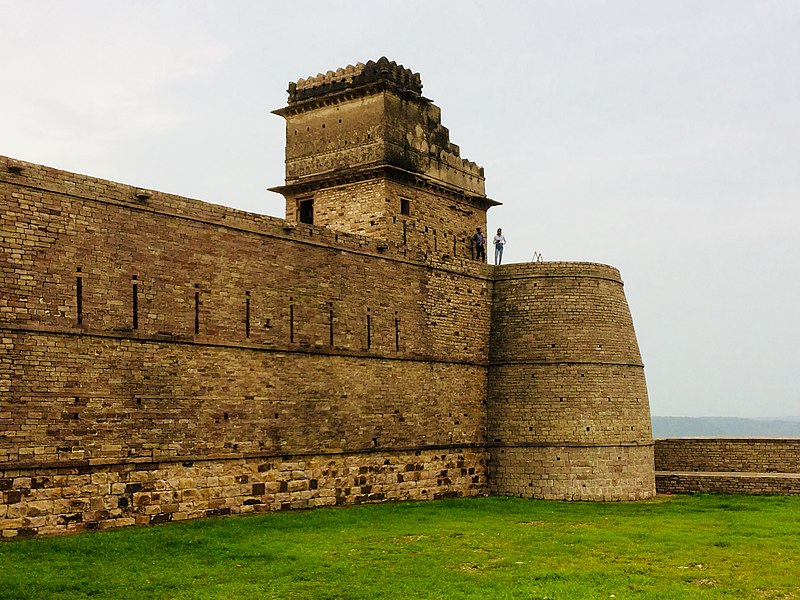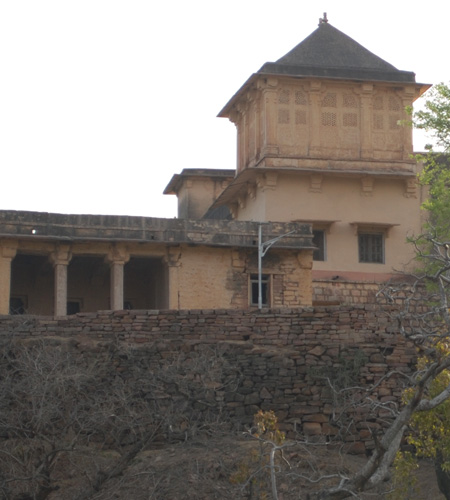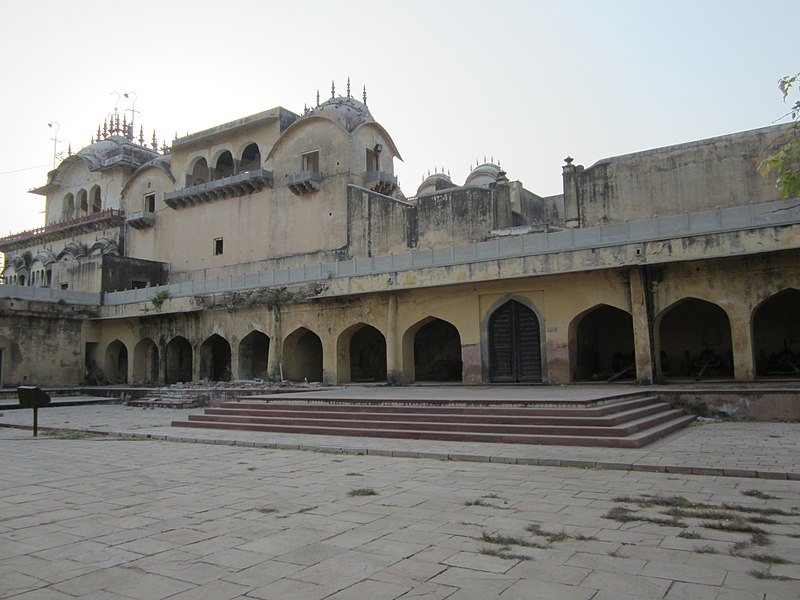Historic places in Chanderi
The town of Chanderi is located on the lush Vindhya hills wrapped in a blanket of greenery of adjoining forests and lakes. It presents a delightful sight through its’ historic monuments and natural wonders. The monumental landmarks of Chanderi stand testimony to the fact that this ancient town was established in the 11th century. Many rulers have controlled this town due to its attractive location on the trade routes to ports of Gujarat, Central India, Deccan etc. The below mentioned places are of the historic monuments from different periods in Chanderi.
1. BADA MAHAL GATE
The Bada Mahal Gate is arguably Chanderi’s defining monument. This is basically a singular structure of a gate that doesn’t lead to any palace or mahal. The gate was built during the reign of Mehmood Shah Khilji in 1450 AD. It is situated at the Southern end of the inner city, facing the Jama Masjid and looking up, it commands a striking view of the fort above. The Bada Mahal Gate has a height of 100 feet and the structure features elaborate carvings and impressive motifs. This gate served the purpose of welcoming and honouring the state guests and visiting kings in a grand manner. The fort town of Chanderi was protected by seven boundary walls surrounding the town and the fort on the hill with each wall having several gates and windows. Many of these gates have been ruined by forces of time and nature. Among them, the Bada Mahal Gate has retained its’ identity and uniqueness.

2. CHANDERI FORT
The Chanderi Fort is the most renowned monument of Chanderi. The fort stands at a height of 71 m above the town on a hill. The fort is fortified with a 5km long wall. The Chanderi Fort dates back to the Mughal period. The Muslim rulers took a lot of initiative to construct the fortification of the walls as it has witnessed several attacks, thus being rebuilt a number of times. The Chanderi Fort is approached through three gates. The first and the main gate is known as ‘Khooni Darwaza’. It is so named because the criminals were thrown from the battlements above and their bodies crashed below. The uppermost gate ‘Hawa Pur’ is the third and highest gate of the Chanderi Fort. The southwest- side of the fort has a gate called the ‘Kati-Ghati’. The remnant of the Fort includes the Khilji Mosque, Naukhada Palace, Tomb of Hazrat Abdul Rahman etc that are present within the fort complex.

3. KHOONI DARWAZA
The first and the main gate of the Chanderi Fort is called the ‘Khooni Darwaza’. It is so named because the criminals were thrown from the battlements above and their bodies crashed below. This gate of the fort was once known for its’ grandeur but as it was attacked and destroyed by Babur, it lost its’ glory followed by many massacres leading to the defeat of Chanderi.
4. KATI GHATI
The Kati Ghati Gate is situated between the Bundelkhand and Malwa areas of Madhya Pradesh. The gateway was carved into an arch shaped structure from a single stone that was cut overnight upon the orders of Chanderi’s Governor, Sher Khan’s son Jimam Khan. The gate is about 80 ft high, 40 ft wide and 190 ft in length. It was believed that the rock was cut down in one night to attack Chanderi and bring down the Mughal arms and cavalry. Jimam Khan had commissioned this gate to be constructed in order to welcome the Sultan of Malwa. Hence, considering the time crunch, Jimam Khan announced a handsome reward to anyone who could cut down the rock in one night. Only one mason could manage to complete the task. When Jimam Khan inspected the gate, he found that there were no hinges to the gate in order to install doors. Considering the work incomplete, Jimam Khan refused to pay the mason. This made the mason disconsolate and he committed suicide at the same spot. Till date, this massive rock gate bears no door.

5. KOSHAK MAHAL
The Koshak Mahal was built by the Sultan of Malwa, Mehmood Shah Khilji in 1445. Initially planned as a seven storey building, the grungy structure has just three complete storeys. Mehmood Shah Khilji constructed this building to memorialise his victory over Sultan Mehmood Sharki in the battle of Kalpi. The Koshak Mahal is a square structure with large impressive arched doorways. The palace consists of four mansions of similar size and equally spaced from one another. All the four mansions of the palace feature identical style of architecture and design. The Mahal was constructed from white local sandstone. A network of passages and overhead covered corridors connect them. The superstructure of the palace does not exist today, but the beauty of the palace can still be felt in the remaining portion standing here.

6. RAJA RANI MAHAL
Chanderi once had 260 palaces, of which only 43 have managed to exist till date. The Raja Mahal is a seven storied palace which still has the grandiose surrounding the landscape of Chanderi. The palace features architectural style of the 15th century. It is a beautiful structure constructed from grey and white sandstone and has elaborate carvings to display. The palace has a magnificent structure that has large courtyards, elegant stairways, beautifully carved pillars and open pavilions on the terrace. The palace has an underground passage connecting it to another palace standing nearby, known as the Rani Mahal, which is quite different in architecture and style to the Raja Mahal. These two palaces are together known as Rajmahal, which serve as prominent points of attraction in Chanderi.

Rani Mahal is one of the two palaces that comprises the Rajmahal. The Rani Mahal is the smaller one of the two palaces which is a four storied structure that is connected to the Raja Mahal through a secret passage. These two palaces, built in close vicinity have very different architectural designs and patterns. This Mahal displays the Bundela style of architecture. The exact period of the palace construction is not known, although it is believed to be prior to the 16th century. The palace is an enclosed structure with a large courtyard surrounding it. The terrace was built with pavilions that were used as watch towers. This palace displays several intelligent architectural specialities, eg; the slit windows were built as a defence policy of the palace, and not for aesthetic reasons.

7.SHEHZADI KA ROZA
Shehzadi ka Roza is an impressive monument built on a 12 feet high podium. The structure is situated near the Parmeshwar Tal. The monument originally had 5 domes but most of them are ruined now. This structure was built in the 15th century by the then Hakim who governed Chanderi. It was constructed in memory of his daughter Mehrunissa. The story is that Mehrunissa had fallen in love with the army chief. But due to the Hakim’s disapproval and after the war, the chief who was seriously injured managed to return to Chanderi. On hearing this, Mehrunissa left to go see him, but before she could reach him, he passed away. Unable to bear this loss, Mehrunissa ended her life next to him, the exact spot where this monument stands today.

8. HATH SAL
Hath Sal is located between two other famous structures of Chanderi, Bala Killa and Khooni Darwaza. Hath Sal is a reminder of the celebrated market places of Chanderi which was built in the earlier part of the 15th century. The speciality of this market place was that the shops were built to serve the pedestrians as well as the elephant riders with equal ease. The shops were built on six tiers of projection which made them gain height. This facilitated the people riding on elephant backs to purchase things while seated on elephants. The structure was built on pillars and came to be known as Hath Sal. ‘Hath Sal’ means the house of elephants. The structure had an impressive architectural quality like lotus designs and jali work, which still amazes people even today.

9. PURANI ADALAT
‘Purani Adalat’ refers to the court of justice that was once functional in Chanderi. The Bundela rulers of Chanderi were responsible for the construction of many important and impressive buildings in and around Chanderi, Purani Adalat was one such structure that lasted over two centuries. The Purani Adalat is a square building having two storeys. The entrance features an impressive embellishment and the ceiling has elaborate carvings of lotus. The front walls are decorated with geometric patterns and the door is decorated with elephant brackets on both sides. The balcony extends ahead of the terrace and a double beam projection supports the structure. Projected balconies feature at the end of the building. The beauty of the building attracts tourists even today.

10. SINGHPUR PALACE
The Singhpur Palace is located in the lush green environment of the Vindhyachal range of hills. The palace is a three-storeyed building that was built by Devi Singh Bundela in the year 1965. This palace was constructed to serve as a rest house to the king during his frequent hunting trips. The beauty of the Palace is enhanced by the presence of a pond nearby. The pond is historically significant as it was built in 1433 by Malik Haiwat Nizam. The beautiful palace combined with the surrounding environment of green forest and placid lake makes this truly alluring.

11. BALA KILA
Bala Kila is a small yet significant fort. The fort was named ‘Bala Kila’ by Cunningham and is situated at the footholds of the hill containing Kirti Durg. The interesting fact about Bala Kila is that there is no gateway near the Bada Mahal Darwaza. The structural design of the fort is typical of the architecture that was prevalent in Chanderi during the 15th century. The defence wall of the fort has a hollow corridor running along the inner wall. The fort has a complex structure, and so holds interest for the tourists.

12. JAMA MASJID
The Jama Masjid in Chanderi is one of the oldest and largest mosques in the state of Madhya Pradesh which boasts of a seating capacity of 2000 people. The design of the mosque is quite conventional with intricate pillars and walls with different geometric patterns. Ghiyas-ud-din Balban constructed this prayer hall to commemorate the victory over Chanderi and ensured this structure imbibed influences of both Mughal and Chanderi heritage. Situated opposite to the Bada Mahal Darwaza, this place still receives a fair amount of footfall by religious leaders and regular people who come to pray.

Check our calendar to know the schedule for the next Go Heritage Runs. Also subscribe to our newsletter to get this information right to your inbox.
Until the next time, Find RunCations near you using the Madhya Pradesh RunCation App- M.P. RunCation App

